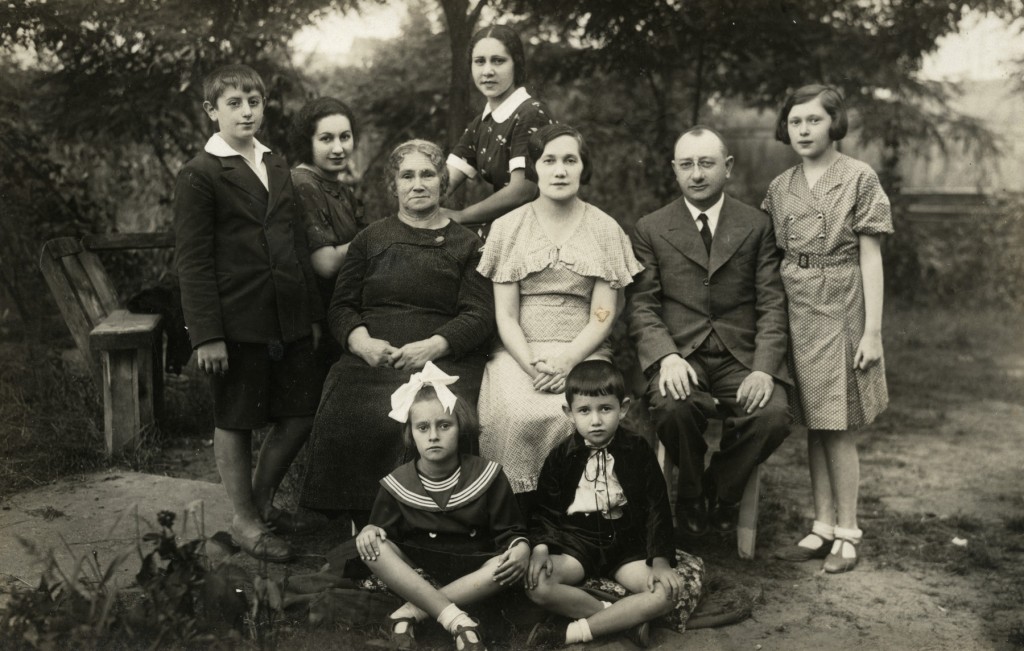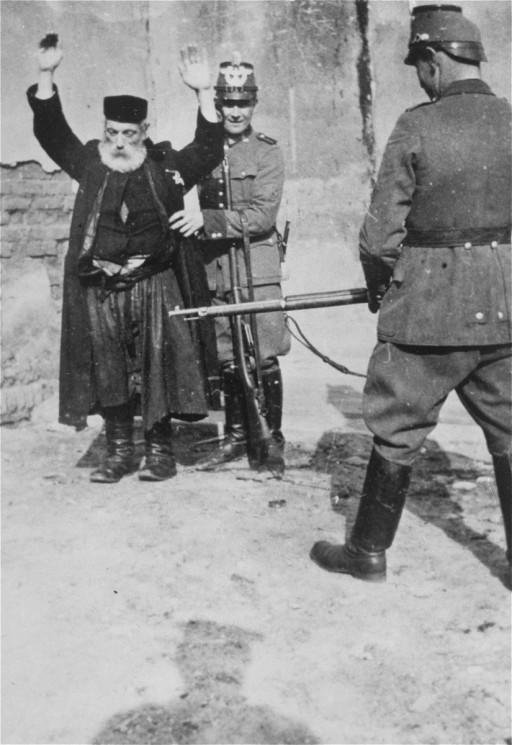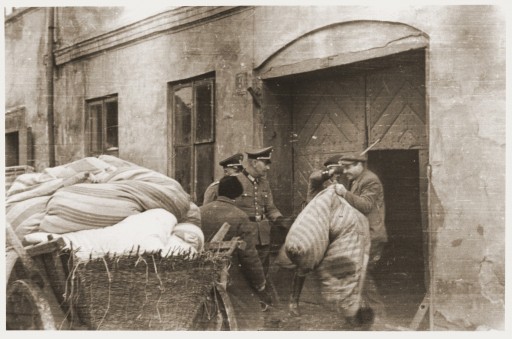
The Order Police
In less than a decade, the Nazis radicalized the German Order Police into a militarized and murderous institution. Order Policemen perpetrated many aspects of the Holocaust. They guarded ghettos, facilitated deportations, hunted for Jews in hiding, and perpetrated massacres of Jews and others. The Order Police contributed greatly to the speed and brutality of the genocide of Europe’s Jews.
Key Facts
-
1
The Order Police were uniformed police forces. They were typically responsible for maintaining public order and enforcing traffic violations.
-
2
As agents of the Nazi regime, the Order Police carried out anti-Jewish policies.
-
3
During World War II, the Order Police perpetrated massacres and facilitated the deportation of Jews to killing centers.
The Order Police (Ordnungspolizei, Orpo) were Nazi Germany’s uniformed police forces.
Typically, uniformed police forces are responsible for maintaining order, directing traffic, and responding to accidents and crimes. The Nazi Order Police did perform these ordinary tasks. However, they also became perpetrators of horrific crimes.
Many people interested in the history of World War II and the Holocaust are familiar with such infamous Nazi organizations as the Gestapo or the SS. While the Order Police is less known, they played a significant role in the Holocaust. They often provided additional manpower for committing crimes organized by other Nazi German policing organizations.
Creating the Order Police
The Nazis came to power in January 1933. Previously, during the Weimar Republic (1918-1933), Germany had numerous decentralized uniformed police forces.
In 1936, these forces became part of the new Main Office of the Order Police (Hauptamt Ordnungspolizei). This office centralized the uniformed police. It was led by Chief of the Order Police (Chef der Ordnungspolizei) Kurt Daluege. Daluege was a longtime SS leader. This reorganization was part of Heinrich Himmler’s efforts to merge the SS and the police.
The Order Police included three subtypes of uniformed police forces. These subtypes were organized according to the population size and density of the community they served:
- The gendarmerie was responsible for policing the countryside;
- The community police, or Gemeindepolizei, policed small towns;
- The protection police, or Schutzpolizei (Schupo), patrolled big cities.
In addition, the Order Police included fire, rescue, and emergency medical services.
Nazifying the Order Police and Anti-Jewish Violence
In the 1930s, the Order Police continued to carry out many of their normal duties. For instance, they were responsible for traffic regulation, order maintenance, and crime prevention. But, the Order Police also underwent Nazification at this time. The institution became aligned with the ideals of the Nazi regime.
The uniformed Order Policemen were agents of the Nazi state. They thus enforced Nazi laws, including anti-Jewish legislation. The Order Police rarely intervened to protect Jews or Jewish-owned property from extralegal Nazi violence. This was the case even when the violence clearly violated the law and caused public disorder.
The Order Police almost never arrested the Nazi perpetrators of such crimes. In July 1935, for example, policemen in the town of Osterode (Ostróda), allowed a crowd of teenage boys to beat and kick a Jewish man in the streets. The boys were not arrested.
Radicalizing at War

The role of the police changed when Germany invaded Poland on September 1, 1939, and World War II began.
Various types of police units deployed alongside the German military. Among them were the Einsatzgruppen. Order Police units also deployed to Poland. These units were called Police Battalions (Polizei-Bataillone). The battalions were militarized units. They participated in combat operations and carried out security duties behind the frontlines. Both Einsatzgruppen and Order Police Battalions engaged in massacres of Poles and Jews.
Expanding the Order Police
According to the Nazi leadership, the Police Battalions had performed well during the invasion of Poland. The Nazis believed that the Order Police would be useful for occupation duties and future military campaigns. Thus, Chief of the Order Police Kurt Daluege decided to create more units. This was especially notable because it meant these young men could not be recruited for military service.
Daluege created a 95,000-man Order Police Reserve. The reserve was made up of non-essential workers in their thirties. Daluege also initiated a recruitment drive for 26,000 younger men. These recruits would serve in the Order Police on a more permanent basis.
Young men in their twenties who did not want to serve in the military or who hoped to build a police career answered the call to join. The new recruits and reservists received a Nazified and militarized form of training. Training did include normal police activities. However, the men were also indoctrinated in Nazi ideology and trained in combat.
Deploying the New Policemen
Many of the recruits and reservists were organized in police battalions of about 550 men. They were led by experienced Order Policemen and young, newly minted, elite Nazi officers.
These battalions deployed abroad as early as 1940. Some went to Norway and the Netherlands (both conquered in 1940). Others were sent to the General Government and territories newly annexed by Germany (both part of prewar Poland). They also deployed to the Protectorate of Bohemia and Moravia. These battalions participated in a variety of security tasks. For example, they protected buildings and bridges from sabotage.
Police units were typically organized geographically and identified by numbers. For instance, Police Battalion 309 was made up of younger new recruits. It deployed from Cologne to the Radom district of the General Government in September 1940.
The Order Police in German-Occupied Poland
Beginning in 1939–1940, Order Policemen behaved with particular brutality in occupied Poland. There, they joined other German occupation forces in the Nazi regime’s persecution of Jews and Poles.
The Order Police helped round up Poles for forced labor in Germany and in German-occupied Poland. They also carried out reprisal killings. The Order Police executed Poles for even minor acts of resistance to the German occupation. There are documented examples of such acts. For instance, Poles were killed for bumping into a German policeman, spitting on a German official, and questioning German authority.
Order Policemen degraded and demeaned Jews. They were known to shave the beards of religious Jewish men. This common antisemitic attack was meant to mock and degrade Jewish religious customs. Order Policemen also abused and beat Jews. And they forced Jews to perform humiliating acts in public. For example, they ordered Jews to dance or perform gymnastics exercises in front of a crowd of mocking onlookers.
Eventually, Order Police units were responsible for guarding some of the new Jewish ghettos. In January 1942, a company of Police Battalion 61 began guard duty at the Warsaw ghetto. There they behaved with impunity. The policemen arbitrarily shot ghetto residents. They even celebrated their victims’ deaths.
The police battalions helped facilitate the “Germanization” of Poland. This plan was supposed to remake the demographics of eastern Europe. It meant forcing hundreds of thousands of people—Jews and non-Jews—to leave their homes to make room for German settlers.
Order Policemen were also deployed in small groups to towns in the German-occupied Polish countryside. There, they were responsible for security. This role was aligned with the larger and more mobile police battalions. Unlike the large battalions, however, these groups typically stayed for months or even years in the same towns. They carried out brutal occupation policies and behaved with impunity.
After the German Attack on the Soviet Union
Police units were responsible for helping the military maintain security behind the front lines. Einsatzgruppen and Order Police Battalions were among them. In 1941, their task took on an especially deadly character.
That June, Nazi Germany attacked the communist Soviet Union. The invasion broke the German-Soviet Pact. One of the Nazis’ goals was to destroy communism, the ideological basis for the Soviet Union. Another goal was to acquire Lebensraum (living space). The Nazi regime sought to expand further east. Notably, this part of Europe had been home to large numbers of Jewish communities for many centuries.
German military and police authorities were instructed to wage a merciless war against Nazi Germany’s alleged racial and ideological enemies. Almost immediately after June 1941, the Order Police Battalions massacred Jews and others in mass shootings. These operations were executed alongside Einsatzgruppen and other SS and police units. On June 27, 1941, Police Battalion 309 perpetrated a horrific massacre in recently occupied Bialystok. They killed 2,000–3,000 Jews. Hundreds of those victims were burned alive in The Great Synagogue.

Mass shootings of Jews became widespread in the summer and fall of 1941. These were perpetrated by the Einsatzgruppen, the German military, and the Order Police Battalions. The battalions participated in some of the most notorious massacres of World War II. In September, Police Battalions 45, 303, and 314 took part in the massacre at Babi Yar on the outskirts of Kiev in occupied Ukraine. They helped murder more than 33,000 Jews there.
The Order Police, Deportations, and the “Final Solution”
Although it is hard to determine the exact date, at some point in 1941, the Nazis decided to murder all the Jews of Europe. They referred to this as “the Final Solution of the Jewish Question.”
The Nazis built killing centers to carry out the mass murder of Europe’s Jews. The Order Police were not typically located in killing centers. However, they were key to ensuring the efficient transport of Jews to those sites. They ensured that Jews from all over German-occupied Europe were delivered to their deaths. Among the transports they aided were those from the Warsaw ghetto, Berlin, and Budapest.
As part of the Final Solution, the Germans murdered Jews living in the ghettos of German-occupied eastern Europe. Beginning in late 1941, the Order Police participated in what the Germans called “liquidations.” These acts were the systematic destruction of ghettos and the Jews living in them. SS and police units, including Order Policemen, either shot Jews in nearby mass graves or deported them. The deportations were usually to killing centers. Afterwards, Order Policemen helped to hunt down Jews who hid from or avoided deportation.
Within Nazi Germany (including Germany, Austria, and the Protectorate of Bohemia and Moravia), the Order Police played a very specific role in the deportations of local Jewish communities: they guarded deportation trains. Beginning on June 14, 1942, for example, a small unit of sixteen Viennese Order Policemen guarded a deportation to the killing center in Sobibor. The journey from Vienna to Sobibor took three days. Approximately 1,000 Jews arrived in Sobibor on that train. Almost everyone on board was immediately murdered.
Order Police guard units also often accompanied deportations from other German-occupied areas for at least part of the journey. In total, Order Policemen guarded more than 700 deportation transports. These transports were from such places as Nazi Germany, Belgium, France, Hungary, the Netherlands, and Slovakia. They also accompanied an undetermined number of deportations from ghettos in eastern Europe. In this way, the Order Police facilitated the murder of hundreds of thousands of Jews. They almost certainly knew the deadly fate that awaited those being transported.
After the war, many Order Policemen claimed not to have been involved in Nazi crimes.







